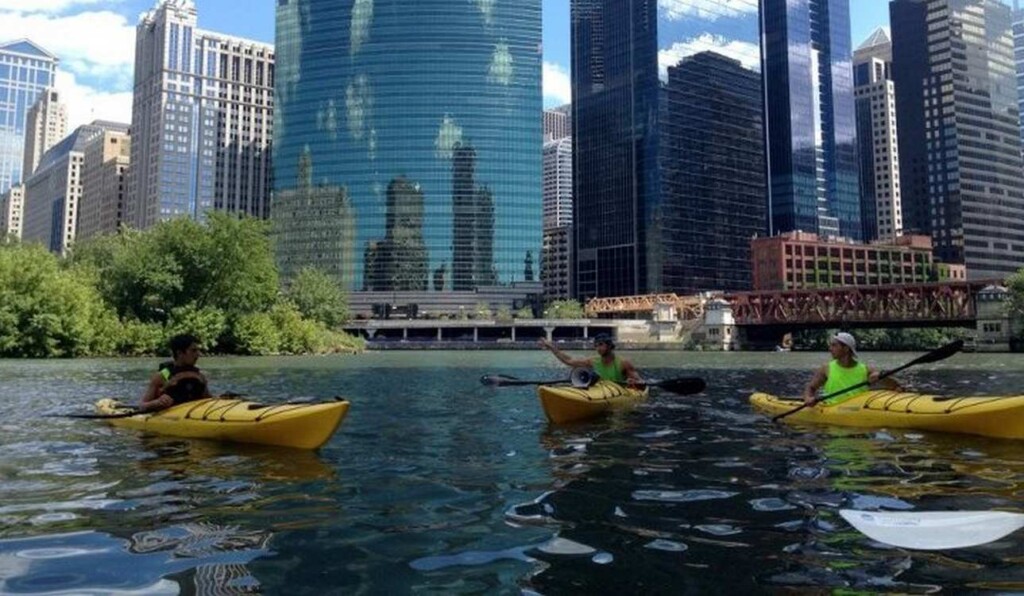
One day, a book will be written about the 21st century, and the topic will be how the denizens in the world’s largest cities cleaned up the rivers which flow through them.
Whether that’s the Yangtze, the Seine, the Mersey, or the Chicago River, humans have well nigh decided that having a clean, odorless, swimmable, and living river is worth the loss in convenience of dumping and polluting.
Even though it turns green every year to celebrate St. Patrick’s Day, that was about the only thing ‘green’ about the Chicago River for the longest time. But following the passage of the 1972 Clean Water Act, things began to change.
It’s now about to welcome swimmers back into its course for the first time in over a hundred years, and many different people, activities, and initiatives have gone into reaching this historic moment.
Before trains reached the Windy City, most goods arrived via boat and barge, and in order to accomodate the traffic, engineers canalized the river by dredging it up and lining its flow with steel panels. This removed all the wildlife and plants that rely on the bank of a river virtually overnight. What was left were a few pollution-tolerant fish species to languish in what was basically a giant metal and concrete log flume.
Waste dumping of all sorts was common, both human and industrial, and as a result, most of the historic architecture along the river doesn’t have any windows facing it.
“Really, the river was the alley. It was gross. You didn’t look at it, even think about it. You sent that water away,” Krystina Kurth, coordinator of conservation action at Chicago’s Shedd Aquarium, told Inside Climate News. “You had all your windows facing the lakefront, but the river was not something that you liked to be around.”
Shedd has been instrumental in leading the transformation of the river which began in 1972 when the Clean Water Act prohibited dumping of any sort without a permit. Not only does human waste contain fecal coliform bacteria that can lead to all manner of bacterial diseases, but also excess nutrients like nitrogen and phosphorous.
As in all freshwater ecosystems, excess nutrients lead to massive blooms of algae which blind and choke other life in the water.
That basic step—stop throwing your poo into the river—was a foundation on top of which was piled millions in civic investments to modernize the stormwater and sewage storage systems to prevent runoff, known as the Tunnel and Reservoir Program.
CLEANING UP CITIES: Historic Tokyo Bridge Liberated from Concrete Overpass Will Shine Again Thanks to Grassroots Campaign
On top of this water management, non-profits like Urban Rivers have aided in providing a helping hand for wildlife species to return. Through their Wild Mile eco-park, Urban Rivers have engaged the public in river conservation by creating an almost mile-long trail of docks which act as a giant buoy system for an entire underwater ecosystem of plants and habitat which the steel box of the Chicago River cannot provide.
From a low of 5 species of fish, there are now 77 recorded as living in the Chicago River, as well as snapping turtles and freshwater mussels which cling to the habitat provided by the Wild Mile.
RIVER NEWS: After Scenic Waterway Declines, Government Sides with Activists to Intervene on the Wye River’s Behalf
Real estate on the northern branch of the river is starting a mini boom powered by a river that’s not longer toxic, that no longer stinks, and which offers a lovely place to walk and relax.
Industrial properties are finding new lives as office spaces and music venues, a blessing made in part by the waters which now give life rather than take it away.
SHARE This Great, Great News About The Next Century In Chicago…


Leave a Reply